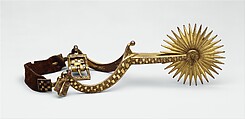Rowel Spur
This luxurious spur made of gilded copper alloy, holding a large rowel shaped as a sunburst, is engraved all over with a chequy pattern and some trefoils. The tabs with hooks holding the straps are enameled in black and white or light blue. The chequy may refer to the heraldry of its original owner, in this case possibly a member of the French Dreux or the Catalan Urgell family. However, the variety of colors of the enameled tabs also suggests that this pattern may be only ornamental.
As a knight’s status was closely related to his horse, spurs became one of the symbols of chivalry, and one of the tokens given to him during his knighting. The wealthy knights and princes would sometimes commission rich examples, gilded, engraved, enameled, or even inlaid with pearls and precious stones.
The first rowel spurs, featured with a revolving disc or star at the end of the neck, appeared in western Europe around the mid-13th century. They cohabitated with the earlier form, the prick spur, for about a century, before replacing it almost completely in Europe by the mid-14th century. The advantage of the rowel spur over the prick was it allowed the rider to reach the flanks of its horse with one of the points whatever the angle of its foot, which was very convenient regarding the riding position of the time, with long stirrups-leathers and extended legs. The fact that the rowel rolled against the horse instead of hitting it directly reduced also the probability of injuring it.
Due to rights restrictions, this image cannot be enlarged, viewed at full screen, or downloaded.

